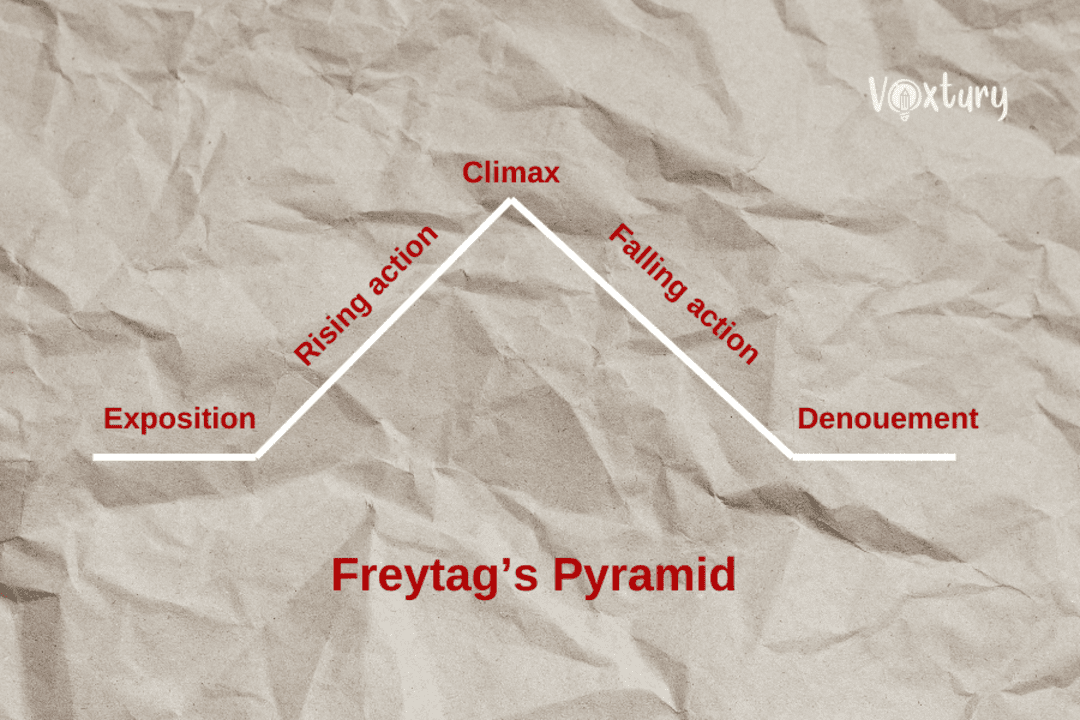A very common tool used in creative writing to come up with the plot structure, Freytag’s Pyramid is a framework for developing stories in which action happens in five acts (although some also say that it can have seven points). A standard not only in books but also in movies and TV shows, it is used more frequently than you’d think. You might be surprised that some of your favorite works actually do use it.
Key Highlights
- Freytag’s Pyramid is a creative writing framework that maps out plot structure. It is typically tragedy-focused but can also be used in other genres.
- It is divided into five elements – the introduction (exposition), the rise, the climax, the falling action, and the resolution (the catastrophe in tragedy).
- Sometimes two additional elements are included – the inciting action and the denouement.
- Freytag’s Pyramid, although a common tool, has some limitations.
What Is Freytag’s Pyramid?
It’s actually quite simple, and we’ve already explained a good bit above – Freytag’s Pyramid serves as guidance, a map if you will, illustrating the dramatic structure of a piece of work. What is dramatic structure? It’s the way the story unfolds and the order in which events happen.
It was developed in the 19th century by a German novelist, critic, and lecturer named Gustav Freytag. The framework was based on Aristotle’s Poetics, according to which “An extended whole is that which has a beginning, middle, and end” – and while that was the baseline for Freytag’s theory, there were quite a few things he included himself.
Just like Voxtury’s online editor is helpful for improving the overall quality of your content, Freytag’s Pyramid is very useful when it comes to plot development. Whether you’re just starting work on your literary piece or are already in the middle of it but feel like the plot is missing something, this framework can help you figure it all out.
DEFINITION
Freytag’s Pyramid is a creative writing framework that divides the plot into five sections: the introduction, the rise, the climax, the falling action, and the resolution. The work’s action is based on conflict, with the main character trying to achieve a specific goal and having obstacles thrown at them. As Freytag’s Pyramid is tragedy-focused, the resolution is also sometimes replaced with the catastrophe.
Elements of the Freytag’s Pyramid

So, what does each element of this framework entail? We’re going to talk about it in this section. We’re also going to explain each of them based on one story – Snow White and the Seven Dwarfs, a classic childhood tale that fits perfectly within Freytag’s Pyramid. However, since Freytag’s Pyramid is tragedy-focused, we will use another example along with it – Romeo and Juliet.
#1 Introduction
Also called an exposition, this part is pretty self-explanatory. In the introduction, we learn information about the characters – their backstories, if they have any – as well as anything else we might need to better understand the plot, such as their relationships with others.
Creating a good introduction is crucial, as otherwise, your reader will be confused about what is happening and might be unwilling to continue reading your book.
Example 1: In the beginning of Snow White and the Seven Dwarfs, we are introduced to the main character – Snow White. We learn about her mother’s death and how her father married another woman afterwards, which is essential to the story, as you later realize.
Example 2: The action of Romeo and Juliet starts with the introduction of the feud between the two families – Montagues and Capulets.
#2 The Rise
In the “Rise” phase of Freytag’s Pyramid, we have a thickening of the plot – the main character moves closer to their goal, but something stands in their way, preventing them from achieving it. The reader is sucked into the action, waiting to see whether the goal will be reached or not.
Example 1: The evil stepmother tells the huntsman to kill Snow White, but he lets her go, unable to fulfill the order. The girl finds a safe space to hide with the Seven Dwarfs. Back home, the stepmother realizes Snow White is still alive and tries to unalive her multiple times.
Example 2: Romeo attends the Capulet party in disguise and meets Juliet, falling in love. The two marry with the help of Friar Laurence, hoping their marriage will bring peace between the families.
#3 The Climax
The climax of the story is the turning point – things can change either for better or worse. Typically, it works in reverse. So, let’s say that the main character of your story has been doing really well up till this point – during the climax, usually something goes wrong, and the situation takes a turn for the worse. If your protagonist has been struggling, on the other hand, their situation might significantly improve after the climax.
When coming up with the climax for your story, you should remember that at this point, the reader should still be unsure about how it’s going to end.
It’s important to understand that the climax will not always be a big, dramatic event – sometimes, the climax of the story takes on the form of an inner realization.
Example 1: After multiple attempts, the evil stepmother finally gets Snow White to eat the poisoned apple when the dwarfs are absent from their home. Our protagonist falls into a death-like sleep.
Example 2: Tybalt challenges Romeo to a duel, which leads to Mercutio’s and Tybalt’s death and Romeo’s banishment from Verona.
#4 The Falling Action
During this part of Freytag’s Pyramid, the results of the climax unfold – it’s usually less impactful on the reader than the previous element, but it is still a crucial part, as the writer explores the consequences of the main event of the story. Authors often hint at the resolution in this part.
Example 1: After becoming unconscious, Snow White is placed in a glass coffin, with the Dwarfs mourning her state. The Prince finds her and becomes enchanted with her looks.
Example 2: Following Romeo’s banishment, Juliet is forced to marry Count Paris. To avoid this, she fakes her death with the help of Friar Laurence.
#5 The Resolution / The Catastrophe
Since Freytag’s Pyramid is more tragedy-focused, oftentimes, the final element is actually called the catastrophe, and it’s when the final failure occurs. The protagonist’s story ends, and typically for tragedy, it does not end well.
However, as mentioned before, Freytag’s Pyramid has been adapted to other genres as well, which is why when it is used with a piece of work that is not a tragedy, the final element is called the resolution and can be either positive or negative.
In this part, the author might also hint at how the characters’ lives progress once the plot concludes.
Example 1: Snow White is wakened up by the Prince with “true love’s kiss,” and the two get married, living happily ever after. Depending on the version of Snow White you’re reading or watching, the stepmother is either punished or dies.
Example 2: Romeo learns the news of Juliet’s alleged death. He buys poison and travels to Verona despite the banishment. He finds Juliet’s tomb and drinks the poison to be reunited with his love. Juliet wakes up and finds Romeo dead – she decides to kill herself with his dagger to be with him. The families end the feud following the tragic death of their children.
The Two Added Steps of Freytag’s Pyramid

Although most people know Freytag’s Pyramid to contain five elements, sometimes two more are added. The first one is called inciting action, and it happens between the introduction and rising action – this is an event that sets the main character’s journey into motion and is actually typically already included in the Introduction part in a 5-element structure.
The second step that is often added to the pyramid is actually already there – some people believe that there should be a distinction between resolution and denouement, so they consider them as two separate elements. In this case, the resolution is how the character tackles the conflict that drives the story, while denouement is the actual ending of the story.
When to Use Freytag’s Pyramid
Not sure if Freytag’s Pyramid is the right framework for your literary piece? Here are a few instances where using it might be a good idea:
- Your story is meant to elicit empathy in the reader. Freyatg’s Pyramid guides the reader through the action and elicits stronger emotions as the reader better understands the character’s experiences, how the climax affects them, and what is at stake.
- Your story focuses on human flaws. If your plot is very character-focused and your main goal is to share with the reader your characters’ strengths and weaknesses, as well as their internal conflicts, then Freytag’s Pyramid is a great framework for that.
- Your reader needs to understand the story well to be impacted by the ending – If you want to really make an impact on your readers with the endings, using Freytag’s Pyramid can be very useful, as it helps them understand the purpose of each scene leading up to the conclusion.
Limitations of Freytag’s Pyramid
Although used frequently, Freytag’s Pyramid is not perfect and has certain limitations. First of all, it’s a linear framework, which might not be applicable to many stories, especially modern ones, that include a multitude of peaks and troughs – by using a single linear path, we lose the complexity and fluidity of narrative progression.
The pyramid can also oversimplify complex narratives that contain multiple subplots and other crucial elements of storytelling, such as character development, thematic exploration, symbolism, and the creation of mood and atmosphere.
The Bottom Line
Since its development in the 19th century, Freytag’s Pyramid has been a popular framework used by creative writers of various genres. Although not perfect, it is still one of the most common writing tools today, especially when it comes to plot structure.
There are plenty of tools that can help you in writing your novel, and at Voxtury, we’ve gathered most of them in our Book Writing section, which is constantly being updated – and once you’re ready to pull the trigger on publishing, we’ve got a bunch of articles about that too.